
Rabbit health advice
Rabbits make very rewarding pets! They are intelligent, fun and inquisitive creatures with strong little personalities.
However, they do live up to 10+ years and so are a long term commitment.
- Environment
- Diet & Teeth
- Neutering
- Handling
- Grooming
- Diseases
- Behaviour
- Bringing your rabbit to the vet
- Bringing your rabbit for a GA
1. Choosing a hutch:
Traditional small hutches can compromise rabbit welfare as they do not allow rabbits to behave normally. A hutch should actually only be viewed as your rabbits’ ‘bedroom’.
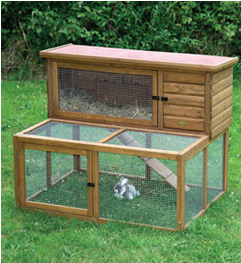 It should be permanently attached to a much larger run or exercise area, so your rabbits can decide when they go outside to stretch their legs.
It should be permanently attached to a much larger run or exercise area, so your rabbits can decide when they go outside to stretch their legs.
A good quality hutch provides shelter and protection from extremes of weather and temperature, is draught-free and predator proof, and is a cosy place to sleep.
Provide lots of bedding for your rabbit to keep your rabbits warm; this should also be safe for your rabbits to eat such as dust-free hay. In the wintertime when it’s particularly cold, you should consider moving your rabbits’ home somewhere warmer such as a shed, unused garage or outhouse; and don’t forget to make sure they can exercise everyday.
The bedroom area should be as big as possible:
• Big enough to allow rabbits to lie down and stretch out comfortably in all directions.
• Tall enough for them to sit (and ideally stand) up on their back legs without their ears touching the roof.
• Long enough to allow at least three continuous hops from one end to the other (make sure there are no obstructions in the way).
• As rabbits should be housed in friendly pairs or groups, their bedroom area should be enough to allow all the rabbits to perform all the behaviours mentioned above at the same time.
2. Giving your rabbit space:
 It’s important that your rabbits have plenty of space to run around, leap, dig, frolic and graze, because this is what happy rabbits like to do. A secure exercise run or enclosure will allow your rabbits to exercise, graze and play safely.
It’s important that your rabbits have plenty of space to run around, leap, dig, frolic and graze, because this is what happy rabbits like to do. A secure exercise run or enclosure will allow your rabbits to exercise, graze and play safely.
• The general rule for the size of the smallest run advisable should be big enough for your rabbit to hop across three times and stand without their ears touching the top. This should permanently attached to your rabbits hutch.
• Preferably, the run should be placed in the garden so the rabbits can enjoy the grass as they would in the wild.
• Make sure the roof of the run is covered and that the run is secure from predators. Make sure the run is escape-proof.
• Make sure you also provide constant access to places to hide in the run, such as boxes or wide tubes. Rabbits are prey animals and need to be able to hide when frightened.
• Provide a ‘digging’ area with child-safe play sand or earth. A dedicated area will help discourage them from digging up your lawn, but make sure the bottom of this area is secure so that your rabbits don’t end up digging their way out of the run.
3. Indoor or Outdoor?
 Some people like to keep their rabbits as house pets, living life indoors and never going outside. Others prefer to keep theirs in a hutch in the garden, perhaps moving them into a garage during the colder winter months – in other words, outdoor rabbits.
Some people like to keep their rabbits as house pets, living life indoors and never going outside. Others prefer to keep theirs in a hutch in the garden, perhaps moving them into a garage during the colder winter months – in other words, outdoor rabbits.
Rabbits can be perfectly happy living either lifestyle, so long as owners take certain precautions:
Indoor rabbits
• Make sure your house is rabbit-proofed. Rabbits will chew through electrical wires and cables, so these must be protected to avoid damage and potential injury – not to mention large repair bills.
• Climate control – if a rabbit is too hot they are prone to gaining weight, as they do not need to burn off any calories to help regulate their temperature. Try and ensure your rabbit’s hutch is kept in a cool, but not cold, area.
• If your rabbit is free to run around the house, it is best not to have wooden or laminate floors. Rabbits cannot grip shiny surfaces, so are liable to slip, risking injury.
Outdoor rabbits
 • Make sure your garden is free of poisonous plants. Rabbits will have a nibble of anything, and eating a poisonous plant can affect your rabbit in a variety of ways.
• Make sure your garden is free of poisonous plants. Rabbits will have a nibble of anything, and eating a poisonous plant can affect your rabbit in a variety of ways.
Some of the most common poisonous plants to watch out for are: anemone, autumn crocus, azalea, begonia, bluebell, busy lizzie, buttercup, carnation, chrysanthemum, clematis, cowslip, daffodil, dahlia, deadly nightshade, foxglove, hemlock, iris, ivy, laburnum, laurel, lily of the valley, poppy, privet, ragwort, rhododendron, tulip, woody nightshade, yew, yucca (please note: this is not an exhaustive list of poisonous plants)
• Outdoor rabbits can become stressed through fear of predators, so try to minimise cases where this may be a problem.
If your neighbour has a dog for example, you should keep your rabbit in an area of your own garden where it cannot see the other animal.
We know rabbits as “fibrevores” because fibre is absolutely essential for their dental, digestive and emotional health.
If rabbits don’t get the right amounts of both digestible and indigestible fibre in their diet, it can rapidly lead to serious health problems.
The main sources of fibre in rabbits’ diet are hay, fresh uncut grass, fresh greens and nuggets.
The hazards of feeding muesli style diets
New research has shown that muesli-style foods can be dangerous for rabbits’ health and wellbeing and should not be fed.
If you currently feed a muesli-type food we recommend you should gradually transfer your pets onto a hay and nugget/pellet based feeding plan over a period of between 14-28 days, by gradually reducing the amount of muesli and increasing the proportion of nuggets until they have completely replaced the mix.
Remember that good quality hay and/or grass should make up the majority of your rabbit’s diet and should be available at all times. Please do not hesitate to call us if you have any questions.
Why are muesli-style foods potentially so dangerous?
Recent research conducted by the University of Edinburgh has shown that feeding muesli, with or without hay, is associated with abnormalities that can lead to painful dental and digestive problems that require veterinary treatment, like
• Lower gut motility, which can put rabbits at a high risk of gut stasis, a condition which is often fatal
• Eating less hay, which can lead to abnormal growth of teeth that could develop into painful dental disease. Lower hay consumption also results in reduction in water intake, which in turn can lead to urinary tract stones or sludge.
• Not eating all their caecotrophs, meaning they may not get all the nutrition they need and uneaten caecotrophs may become matted in rabbits’ fur, putting them at risk of dermatitis and fly strike
• Selective feeding (where rabbits pick out their favourite pieces rather than eating the whole portion), which can lead to an imbalanced diet lacking in vital vitamins and minerals.
• The research has also shown that eating muesli-style foods without hay causes rabbits to become overweight or obese, which can also lead to health problems
Digestive Health
Rabbits need two kinds of fibre in their diet; digestible and indigestible, together we call this Beneficial Fibre. The first gives them essential nutrients and the second keeps their digestive system moving effectively.
Indigestible fibre passes through their digestive system and is excreted as separate, round, hard droppings.
This process keeps the digestive system moving and stimulates their appetite. Digestible fibre is moved into a part of the gut called the caecum – this is like a giant appendix.
 Good bacteria in the caecum ferment the fibre which then emerges in the form of clumps of sticky droppings called caecotrophs.
Good bacteria in the caecum ferment the fibre which then emerges in the form of clumps of sticky droppings called caecotrophs.
Rabbits then re-eat the caecotrophs and their systems extract essential nutrition as the digestible fibre passes through for the second time.
Rabbits will eat the caecotrophs directly as they pass from the body, generally at quiet times of the day/night, so in a healthy rabbit caecotrophs should never be seen. Finding caecotrophs in the hutch or stuck to your rabbit can be a sign of poor gut health, so a consultation with one of our vets would be advised.
Failing to provide adequate portions of the right kind of fibre can rapidly lead to illness, which can sometimes be fatal.
Emotional Health
In the wild 70% of a rabbit’s time above ground is spent searching for grass, hay, plants, herbs and bark to eat. This foraging and chewing behaviour keeps rabbits busy, stimulated and exercised. So the right diet is essential to rabbits’ emotional wellbeing as well as keeping their teeth healthy.
Dental health
Rabbits’ continuously growing teeth must be kept worn by chewing grass and hay; otherwise the teeth grow too long.
 As the crown length increases the top and bottom teeth start pressing together when the mouth is closed which restricts further eruption, but tooth growth continues so they start curving and developing sharp painful spikes in the mouth, and the roots push backwards into the jaw and skull.
As the crown length increases the top and bottom teeth start pressing together when the mouth is closed which restricts further eruption, but tooth growth continues so they start curving and developing sharp painful spikes in the mouth, and the roots push backwards into the jaw and skull.
It’s these overgrown tooth crowns and roots that cause so many problems for fibrevores.
Signs that a rabbit is suffering from dental problems include runny eyes, wet chins, jaw swellings, facial abscesses, difficulty eating, weight loss and a reduction in the amount of faeces being produced.
If you observe any of these symptoms please call us at Cottage Vet Clinic immediately.
Feeding your rabbit correctly
Rabbits need to keep their digestive systems busy with a mix of two kinds of fibre moving through the gut at all times (these types of fibre are called digestible fibre and indigestible fibre, which we collectively call ‘Beneficial Fibre’)
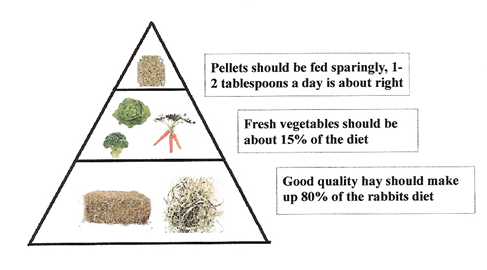 Rabbits can’t get enough nutrition from fibre when it passes through their gut the first time, so they pass it through a second time, by eating their poo!
Rabbits can’t get enough nutrition from fibre when it passes through their gut the first time, so they pass it through a second time, by eating their poo!
Indigestible Fibre is moved through their digestive system and excreted as separate, round, hard droppings.
This type of fibre keeps the digestive system moving and their appetite stimulated.
Digestible Fibre is moved up into an organ called the caecum – which is like a giant appendix. Good bacteria in the caecum ferment the fibre, making it easy to digest.
This emerges in the form of clumps of sticky droppings – we call these droppings caecotrophs. Rabbits then re-eat the caecotrophs (soft faeces) and their systems extract the essential nutrition when the digestible fibre passes through for the second time.
If rabbits don’t get the right amounts of both digestible and indigestible fibre, it can rapidly lead to serious health problems.
Sticking to The Excel Feeding Plan will ensure your bunnies get the right amounts of fibre in their diet.
The Excel Feeding Plan was developed in conjunction with one of the world’s leading small-animal vets, to provide a perfect daily balance of fibre and nutrition.
Excel Feeding Plan:
 Step 1 – Herbage and Forage – High quality hay and grass foods should form the majority of your pet’s diet (75-80%).
Step 1 – Herbage and Forage – High quality hay and grass foods should form the majority of your pet’s diet (75-80%).
Step 2 – Excel nuggets – Excel Tasty Nuggets are a single component food and are high in ‘Beneficial Fibre’ which means they’re great for digestive health. Feed 1-2 tablespoons to your rabbit daily to keep him/her healthy.
Step 3 – Fresh Greens – Feed fresh greens daily to give additional nutrients and provide variety in your rabbit’s diet.
Good Greens: asparagus, basil, cauliflower leaves, celery, chicory, dill, fennel, green pepper, kale, mint, oregano, parsley, red leaf lettuce, romaine lettuce, savoy cabbage, spinach, turnip, watercress, dandelion leaves
Bad greens: avocado, carrot, cucumber, iceberg lettuce, potato and potato tops, rhubarb (leaves and stalks), tomato leaves, locust pods and beans.
Step 4 – A plentiful supply of clean fresh water should always be available.
 We recommend that all pet rabbits should be neutered. In females, it prevents unwanted pregnancy and eliminates cancer of the uterus, but it makes both sexes calmer and less aggressive.
We recommend that all pet rabbits should be neutered. In females, it prevents unwanted pregnancy and eliminates cancer of the uterus, but it makes both sexes calmer and less aggressive.
Does can be neutered from 14 weeks, while bucks can undergo the procedure as soon as their testicles have descended(around 3 months of age).
It’s important to remember that bucks can remain fertile for four weeks after the operation, so should not be kept with an un-neutered doe during this time…or you may get more than you bargained for!
 Rabbits need time to get used to their surroundings, so don’t try to pick your new rabbit up for the first few days.
Rabbits need time to get used to their surroundings, so don’t try to pick your new rabbit up for the first few days.
Techniques for handling a rabbit will vary according to the size of the animal, but it is important that a rabbit feels safe whenever it is picked up.
This can be especially important with younger children – although they are often keen to cuddle their pet, they can accidentally be too rough.
When handling rabbits, you should remember that they’re ground-living creatures who can find being lifted and carried distressing, so whenever possible interact with your rabbits at ground level.
Owners should also remember not to approach from above (as a predator would), but rather on the same level. When picking your rabbits up ensure that all four legs and the bottom are securely supported at all times.
A rabbit should never be picked up just by the ears or the scruff of the neck.
Some rabbits are not happy to be handled, which could be a result of not being handled regularly – or properly – as a baby. It’s important to move slowly and quietly when handling such animals, so as not to increase their level of anxiety.
It can take some time to overcome handling anxiety, but is often helped by gradually introducing stroking and handling whilst feeding your pet a treat such as a piece of carrot.
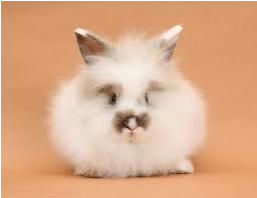 Some breeds of rabbit, particularly the long-haired varieties, need brushing daily to remove loose and matted hair.
Some breeds of rabbit, particularly the long-haired varieties, need brushing daily to remove loose and matted hair.
This is important to reduce the risk of hairballs and flystrike. It also keeps your rabbits in good condition, and helps to improve the relationship between you.
Be careful to be gentle when brushing long haired rabbits, as their skin can tear very easily if you pull on their fur too hard.
Keeping your rabbit fit and healthy is vital to ensure a long, happy and fulfilling life. Rabbits can be prone to some health issues which can prove challenging to treat, but can often be easily prevented if you know how.
Good care, appropriate feeding and other appropriate measures such as vaccination are key. Some of the most important health problems that can be encountered and how to prevent them are listed below:
Infectious diseases
Myxomatosis is caused by a virus spread by fleas, mites and biting flies such as mosquitoes. In some circumstances it can also spread by direct contact between infected rabbits too.
The first signs of infection are usually puffy swellings around the head and face. Within a day or so, these swellings can become so severe that they can cause blindness.
‘Sleepy eyes’ are another classic sign, along with swelling around the mouth and ears, which then spreads around the anus and genitals.
A high fever occurs and eating and drinking becomes progressively more difficult. Death usually follows within around twelve days.
Recovery from this disease is rare and euthanasia is often necessary to prevent suffering. Occasionally a longer and more protracted disease course occurs with multiple skin modules. All types of rabbits can be affected, including house rabbits.
Rabbit Haemorrhagic Disease (RHD), also known as Viral Haemorrhagic Disease (VHD) is a very serious condition which causes a high fever, internal bleeding and liver disease.
It is usually rapidly fatal and is spread by direct contact between rabbits (both wild and domesticated) and indirect contact, such as via insect transport or people, clothing, shoes and other objects.
Regular flea and fly control measures and avoiding pet rabbits coming into contact with areas wild rabbits have been, can help to lower the risk of infection.
Both diseases are widespread and endemic in wild rabbits in Ireland. The devastating nature of these diseases means that vaccination against both diseases is recommended to protect pet rabbits.
Although separate vaccines were needed in the past, dual protection against both diseases is now available from a single convenient annual vaccine.
This vaccine should be given annually starting from 5 weeks of age – please call us to arrange a consultation for your rabbit.
Flystrike
Flystrike is a common, extremely distressing and often fatal disease which predominantly occurs in warm weather.
It most commonly occurs when the rabbit’s rear end becomes soiled with faeces and/or urine. This attracts flies which lay eggs on damaged skin or on the soiled fur. These eggs then hatch into maggots that eat away at the tissues in the surrounding area and release toxins which makes the rabbit unwell.
The problem, if left untreated, can get so bad that the maggots reach the rabbit’s abdomen, causing so much suffering that the rabbit has to be put to sleep. If you spot any signs of flystrike on your pet, such as eggs or maggots, please contact us immediately.
You can prevent flystrike by:
• Keeping housing clean and dry.
• Feeding the correct high fibre diet to make sure they eat all of their caecotrophs (see our diet section for more information)
• Checking your pet thoroughly for signs of illness, injury or abnormal behaviour every day, and in warm weather checking the fur and skin around your pets’ rear end and tail area, at least twice a day.
• Removing any wet or soiled bedding every day.
• Keeping rabbits active and healthy – obese rabbits may be too big to clean themselves effectively or to eat their caecotrophs (which then build up around their rear end).
Fleas
The fleas most commonly found on domestic rabbits are the same species of flea as will most likely be affecting all other pets, and you, in the household.
Rabbits’ symptoms can be varied, from itching to severe scratching of the neck and biting of the area around the base of the tail and some show no signs at all.
Treatment should focus on both the animal and environmental approach so as to minimise the level and persistence of infestation. Only use treatments and medicines designed for rabbits, some treatments/medications designed for other animals can be harmful and in some cases fatal to rabbits.
At Cottage Vet Clinic we supply Advantage spot-on treatments which can be applied monthly to prevent fleas in your rabbit.
Mites
Cheyetiella is a type of skin mite that can affect rabbits; it lives in the fur, and causes areas of thick crusting and dandruff type material to develop.
It is often termed ‘Walking Dandruff’, with affected areas most commonly being at the back of the neck and at the base of the tail.
We can easily diagnose these mites by examining some of the dandruff material under the microscope, and will then be able treat your rabbit effectively.
Rabbits can also be affected by ear mites that cause crusting and ulceration of the ear canal.
People often think rabbits are very easy to look after and that all they need to do is pop them in a hutch in the garden and feed and clean them when needed. However this is actually far from the truth!
 • Rabbits are prey animals first and foremost and their natural response to a perceived threat is to often run and hide. They have a wonderful ability to interact with humans but need time and regular, gentle handling from an early age to become comfortable around humans.
• Rabbits are prey animals first and foremost and their natural response to a perceived threat is to often run and hide. They have a wonderful ability to interact with humans but need time and regular, gentle handling from an early age to become comfortable around humans.
• Offer your rabbits lots of bolt holes/hiding within their home and areas they have access to. Open spaces with no protection will cause your rabbits to feel under threat. A good idea is to place the carrier inside the homing area so increase familiarity and reduce stress
• Think about what other animals are already in your house, and whether they are a natural predator to rabbits. For example rabbits will feel scared being housed next to dog kennels or ferret enclosures! Make sure your rabbits can always escape and hide if they feel afraid.
• If a rabbit’s behaviour changes or they show regular signs of stress or fear (such as frequent hiding or being aggressive to you/or other pets), they may be in pain, distressed and /or suffering emotionally.
We would recommend a health check up for your pet to rule out any form of illness or injury that could be causing the behaviour problem.
How to create the perfect environment for your rabbit:
Pet rabbits often lack stimulation, which can lead to behavioural problems and poor health. Much like humans, they need to be kept physically and mentally active. You can replicate a rabbit’s natural environment by providing some of the items below:
• Tunnels (that are wide enough for the rabbits to pass through easily)
• Tree stumps (from trees that are safe for rabbits to chew, e.g. apple, that have not been sprayed with chemicals) to act as look out points (platforms)
• Safe, unsprayed twigs (which can be hung up so that they can pull them)
• Suitable toys (there are many rabbit toys available commercially; ensure any you buy are safe and that your rabbits use them)
• Digging Box i.e. A planter filled with earth for digging
• Platforms for hiding under and climbing on
• Constant access to safe hiding places (such as cardboard boxes)
• Games, such as food items in brown paper which they have to unwrap
• Put food in multiple places so they have to move around to find it
• Use food balls (the treat balls made for cats work well) to feed their nuggets as they will spend longer eating and have fun chasing them around
Company:
Rabbits are very social animals and if left without appropriate company or things to do for prolonged periods they can suffer. Rabbits have complex social needs and are happiest when kept with another friendly rabbit – therefore, rabbits should ideally live in friendly pairs or groups.
However, keeping the wrong pairings together can lead to unwanted kittens (baby rabbits) and/or fighting. Neutering is recommended to prevent unwanted kittens.
A good combination is a neutered male and neutered female rabbit.
Neutering is important to prevent unwanted pregnancies and to reduce fighting especially in same sex pairings. Unfamiliar rabbits need to be introduced to each other very carefully and gradually, under owner supervision, preferably in a space that is new to both rabbits
It’s very beneficial for rabbits to start socialising with people and other rabbits from an early age.
Familiarity with people will help your rabbits develop into friendly and confident adults. Exposing them to normal everyday sights and sounds from a young age is also important, so they’re relaxed and happy in the environments they will encounter as adults.
Guinea Pigs:
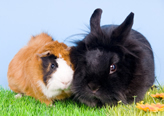 Contrary to popular belief, guinea pigs should NOT be kept as companions for rabbits. They have different dietary requirements and communicate differently too.
Contrary to popular belief, guinea pigs should NOT be kept as companions for rabbits. They have different dietary requirements and communicate differently too.
Furthermore, rabbits can sometimes bully guinea pigs and can pass a bacteria onto
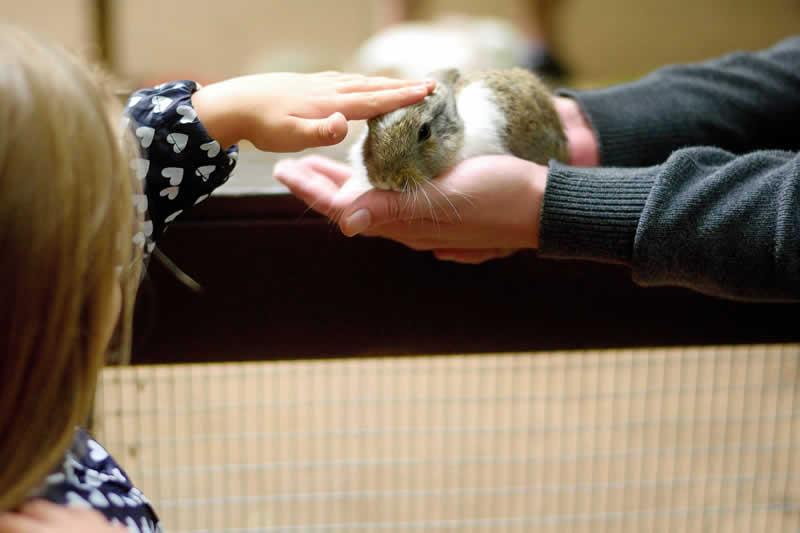 Sometimes you will have to take your rabbit to the vet, for neutering, vaccinations, dental checks or because he or she has fallen ill.
Sometimes you will have to take your rabbit to the vet, for neutering, vaccinations, dental checks or because he or she has fallen ill.
Since rabbits are prey animals they are easily frightened so it’s important to make the visit to the vet as comfortable as possible.
The ideal rabbit carrier:
• It should be solid, non-collapsible, well ventilated and secure to ensure rabbits cannot chew or escape (never use a cardboard box – they can be easily chewed or become insecure if it rains or they urinate)
• Ensure it is of suitable size and shape so that the rabbit is comfortable enough to lie and move around as freely as possible. But it should be small enough to provide feelings of security and to stop them sliding around during travel.
• Sometimes a top opening is helpful to easily take out a nervous rabbit once at the vet
• Line the carrier with newspaper to absorb urine and a towel or vetbed (only if you are sure your rabbit will not chew them, otherwise hay from their bed might be more appropriate)
• Make the carrier as familiar as possible, so place inside hay from home, a favourite toy and some used bedding
• Make the carrier familiar to your rabbit first by leaving it in their enclosure with the door open to encourage them to investigate. Rabbits should not be pushed into the carrier – try to entice in with a healthy snack.
• Unsuitable rabbit carriers include wire pet carriers, fabric carriers, wicker baskets and cardboard boxes.
Rabbits that live together and are friends should travel together.
If you have more than one rabbit at home, it’s sensible to take them both to the vet in the same carrier, even if only one needs to be checked.
There is “safety in numbers” and the companionship will help reduce their stress levels.
When out and about the rabbits will absorb the same smells – if only one rabbit is taken, at home it can mean rejection from the companion rabbit if they smell different.
Bringing your rabbit/guinea pig in for a general anaesthetic / surgical procedure
• Fasting: We will usually ask you not to give your dog or cat any food after midnight, the night before the procedure.
However the rules are different for rabbits – do not take the food away, in fact bring them in with their hay/grass etc. in the cage.
• Drinking: Allow free access to water (but no other fluids) at all times and bring their normal water bottle/bowl with them to the clinic
 • When you come in: Please bring rabbits/guinea pig in a secure cage. If your rabbit/guinea pig has a mate please bring him/her too – this helps to reduce stress.
• When you come in: Please bring rabbits/guinea pig in a secure cage. If your rabbit/guinea pig has a mate please bring him/her too – this helps to reduce stress.
Rabbits/guinea pigs may be transferred to a quiet room or admitted directly to the hospital to minimise stress. In the waiting room cages should be placed on the benches or counter, not on the floor so that
your pet feels safer.
We will weigh your pet and we will ask you to fill in a consent form for the procedure. This will include some important questions about your pet’s health and will take a few minutes to read and complete.
Ensure we have a contact phone number for the day. Please allow at least ten to fifteen minutes for hospital admission. Most procedures will be ‘day surgeries’ so we will usually be able to discharge your pet between 4 and 6 o’ clock the same day.

